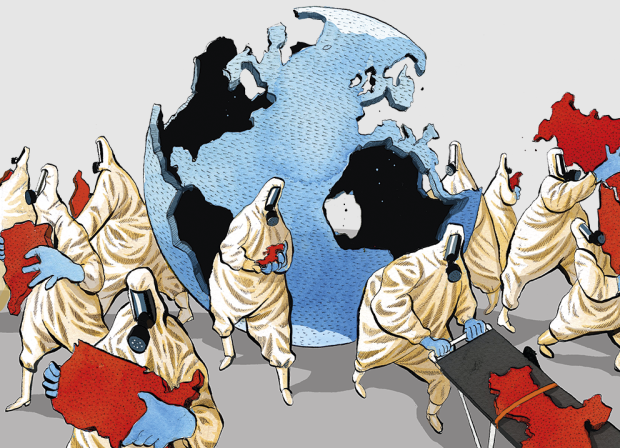The year 1976 rises like a spectre whenever the sun shines for more than a few days. That long, dry, hot summer has become a regular reference point for people in their late forties and over searching for happy memories of childhood or young adulthood. Those too young to remember it will nevertheless be familiar with photographs of people dipping in the fountains in Trafalgar Square, walking alongside dried-up reservoirs or showing a ‘Blitz spirit’ as they filled buckets from standpipes in the streets.
Yet rarely does anyone see the summer of 1976 in a clear light: as a time when our then state-owned water industry failed to cope with adversity. We hear plenty of criticism from the left about the privatised water industry we have now, which Jeremy Corbyn has promised to renationalise. Water companies stand accused of frittering their money on dividends rather than investing it in infrastructure. But the evidence points the other way — we are more resilient to drought now than when we were reliant on public-owned regional water authorities.
What is forgotten about the 1970s is that water restrictions were then a common part of life, as were power cuts. And 1976 was not even the driest summer of the 20th century — that honour belongs to 1995. The years 1933 and 1934 saw almost as dry conditions. But in 1975/76, water restrictions began remarkably early. The first hosepipe bans were put in place in June 1975, after just a few weeks of dry weather. The first standpipes — in Barnsley — appeared on the streets by October of that year, although in the event they weren’t used. By the third week of July 1976, 100,000 households in Wales were having their water cut off every night, extended to a million homes two weeks later.
This year we have experienced what has so far been a shorter but more intensive drought than that of 1976. We have gone two months with almost no rain over much of the country. Yet the first hosepipe bans are only now being established and there is no prospect of standpipes in the streets. A report this April by the National Infrastructure Commission concluded that water supplies over virtually the whole country can cope with a once-in-a-century drought. Were the weather of 1975 and 1976 to be revisited on us now, we would not be queueing up with buckets.
Yet all this said, the water industry is still far from satisfactory. The market remains undeveloped and there is still too little incentive to manage water well. Twenty per cent of water is lost to leaking pipes in the distribution system — a little down on the mid-1970s but still a disgraceful quantity.
Astonishingly, half of domestic properties in Britain have no water meter. Their occupiers can use as much water as they like without facing any marginal cost — they just pay a standing rate. Homes with water meters have been found to use 17 per cent less water than those without. Moreover, the absence of water meters makes it impossible for water companies to manage supplies during the early stages of a drought by gently increasing prices in order to cut demand.
Ever since privatisation in 1989, the industry has always resisted compulsory metering because it fears that this could lay open the way to competition, eliminating the cosy regional monopolies which water companies currently enjoy. In 2014 the government passed legislation which provides for competition in the commercial market but does not extend to households. They will continue to be denied the choice they enjoy when it comes to gas and electricity suppliers.
It is difficult to understand the government’s reluctance to create a fully competitive water market. Time and again market forces have proved themselves by far the best way of matching supply with demand and managing scarce resources. The alternatives tried in 1976 pale by comparison. They might have seemed amusing at the time — the Labour government’s ‘minister for drought’, Denis Howell, boasted of how he had put a brick in his cistern and had started taking baths with his wife — yet they relied on a community spiritedness which was patchy at best. While some eked out their water, others sprayed their lawns until threatened with prosecution. The end result was rationing by the crude means of turning off the water supply to people’s homes.
It isn’t hard to imagine what would happen if supermarkets resorted to the same system of charging for food as water companies still do for water in many cases: charging people for a trolley but then allowing them to fill it up at no further expense. Their shelves would be stripped bare in minutes, after which they would be forced to resort to some kind of rationing. With their monopolies guaranteed, would they have much incentive properly to refill the shelves?
The 1976 drought was supposed to lead to a complete rethink in water supplies. Instead, when the rains came in September, Howell was briefly transformed into minister of state for floods, before resuming his normal job as minister for sport. The impetus was lost. Forty-two years later we are still working our way towards a water industry which is properly resilient against drought.
Got something to add? Join the discussion and comment below.
Get 10 issues for just $10
Subscribe to The Spectator Australia today for the next 10 magazine issues, plus full online access, for just $10.
You might disagree with half of it, but you’ll enjoy reading all of it. Try your first month for free, then just $2 a week for the remainder of your first year.














Comments
Don't miss out
Join the conversation with other Spectator Australia readers. Subscribe to leave a comment.
SUBSCRIBEAlready a subscriber? Log in